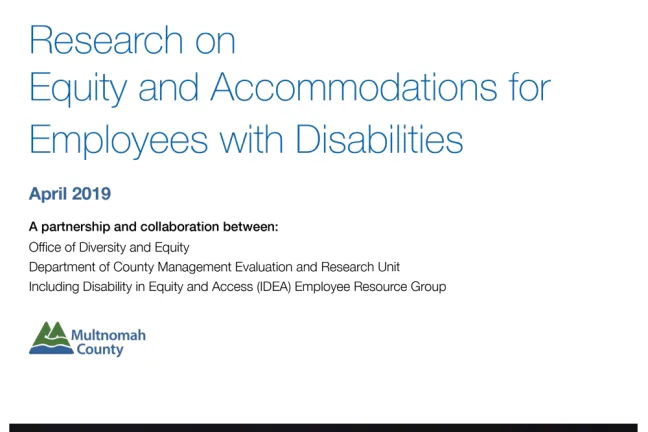Who are the disabled employees of Multnomah County? Some of us have mental health issues, arthritis, hearing loss, vision loss, scent sensitivity, migraines, cancer, mobility issues, alcoholism and addiction, chronic pain, and a variety of other conditions that affect our day-to-day lives. Some of us were born with a disability, and some of us acquired a disability later in life. Some of us have a single disability while others of us have multiple disabilities. And some of us have a temporary disability while others of us have a permanent disability. Most importantly, we want you to know that we are your co-workers and we are a diverse group, with different talents, interests, needs, and experiences. We are likely working next to you.
- Jill Jessee, Co-Chair, IDEA and Administrative Analyst, Director's Office, Department of County Human Services
That excerpt is from the preface of a recently released report,
which leaders from the Including Disability in Equity and Access (IDEA) Employee Resource Group and County researchers presented to the Board of Commissioners on April 2.
The project and resulting report reflect efforts to respond to troubling trends in the 2015 and 2017 Countywide Employee Surveys. In those surveys, employees with disabilities reported consistently low satisfaction and felt negatively viewed by their co-workers.
Based on these survey findings, as well as feedback from Employee Resource Group members and leaders at listening sessions, researchers from the Office of Diversity and Equity and the Department of County Management Evaluation Research Unit, with County leaders' support, sought a deeper understanding of the experiences and needs of employees with disabilities.
An important aspect of this project was embedding an equity lens in the design and process. Core values included engaging with stakeholders and ensuring that employees with disabilities led the work as co-creators. That meant County researchers worked with the IDEA Employee Resource Group on all aspects of the project, from the initial design through finalizing the report.
During the design phase, IDEA members were clear that a better understanding of employees' experiences with accommodations could help strengthen and improve the County's Americans With Disabilities Act (ADA) accommodation process. Among other things, accommodations play a role in employees' experiences of safety, trust and belonging, as well as their ability to work effectively.
Fifty-four employees participated and reported having a range of disabilities. Some had visible disabilities, meaning their disabilities are obvious to others (such as a mobility impairment), while a majority reported having non-visible disabilities, meaning their disabilities are not apparent to others (such as a mental health diagnosis or chemical sensitivity).
This mirrors findings from the 2017 Countywide Employee Survey that indicated many more employees experience non-visible disabilities compared to visible disabilities. Non-visible disabilities can be difficult for employees, because the burden to inform others about their disabilities falls on them, and because their co-workers and managers may have a hard time understanding their need for accommodations.
Many employees in the project expressed the need to better educate employees and managers about different types of disabilities, the experiences of employees with disabilities, and the accommodation process.
The project's findings are based on analyses of qualitative data from interviews, focus groups, and anonymous questionnaires. The findings centered on three interrelated themes:
- The need for organizational changes and a cultural shift
- How leadership, co-workers and other staff affect people with disabilities
- Requesting and implementing accommodations
Some recommendations include:
- Using Universal Design in all County practices and policies as part of a larger strategy that addresses stigma and both structural and systemic barriers.
- Encouraging and supporting participation in the IDEA Employee Resource Group
- Ensuring all County leaders, managers, Human Resources staffers, and all co-workers consistently demonstrate the Core Competencies of Promoting Equity, Leadership, Relationship Building, and Communication.
- Assigning a full-time position to lead a core group of ADA specialists who support employees with disabilities.
- Streamlining and removing barriers to the accommodation process.
For more information about the project's findings and recommendations, see the
or
.
The centering of experiences, and the inclusion of and collaboration with the most negatively impacted employees are central themes to equity and were a main focus of this project. This work aligns with broader efforts to advance workforce equity, including specific attention to employees with disabilities in the Workforce Equity Strategic Plan and the vision for an organization where all employees feel a sense of safety, trust, and belonging.
Related documents


